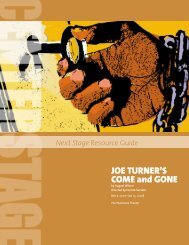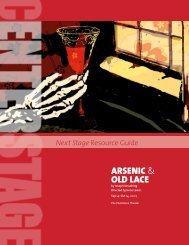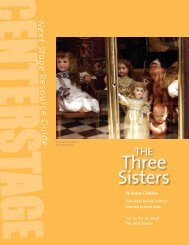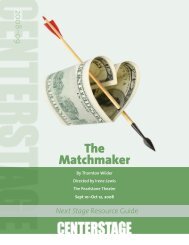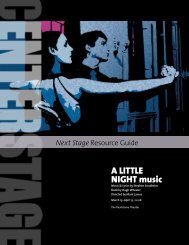You also want an ePaper? Increase the reach of your titles
YUMPU automatically turns print PDFs into web optimized ePapers that Google loves.
People & Things continuedBette DavisApril 5, 1908–October 6, 1989Bette Davis is remembered almostas much for her fiery personalityand off-screen battles as she is forher six-decade film career, whichspanned nearly 100 movies and10 Academy Award nominations,including Oscar wins forDangerous and Jezebel. Born inLowell, Massachusetts, and oftenreferred to as either “The Queenof Hollywood” or “The First Ladyof the American Screen,” DavisBette Daviswas the first woman to head theAcademy of Motion Pictures Arts and Sciences and the first actress toreceive the Lifetime Achievement Award (1977) from the American FilmInstitute. Known for her scathing wit and often combative demeanor,Davis was notoriously considered to be hard to work with, and hadseveral high-profile rivals, including fellow actress Joan Crawford. Shealso claimed to have nicknamed the Academy Award “Oscar.” Davisspent most of her later years acting in TV movies—garnering an EmmyAward for Strangers: The Story of a Mother and Daughter (1979)—before succumbing to breast cancer in 1989. She is also known for thatsong about her eyes.Notable films: Dangerous (1935), Jezebel (1938), All About Eve (1950),Whatever Happened to Baby Jane? (1962)Charlie ParkerAugust 29, 1920–March 12, 1955Originally nicknamed “Yardbird”—later trimmed to “Bird”—CharlieParker is widely considered the best and most influential jazz saxophonistof all time. He became a figurehead for the Beat generation and a founderof bebop, and incorporated melody, rhythm, and harmony in such aninnovative way that he was able to maintain a creativity that pleasedboth critics and the masses. He was also known to fuse other musicalstyles into his jazz, including classical and Latin music. Born and raisedin Kansas City, Parker moved to New York in 1939. There, he workedseveral jobs to pay the bills while playing music in after-hours bars inHarlem with the likes of trumpeter Dizzy Gillespie, pianist TheloniusMonk, and guitarist Charlie Christian. It was during this time that theydeveloped bebop. As a teenager, Parker was injured in an auto accidentand subsequently developed a morphine addiction, which turned intoa heroin addiction in his adult years. Though his death at the age of34 was officially ruled to be the result of pneumonia and a bleedingulcer, Parker’s heroin habit surely contributed, severely shortening anonetheless brilliant career.Charlie ParkerNotable recordings: Bird & Pres (1946), Bird & Diz (1950), SummitMeeting at Birdland (1951), The Greatest Jazz Concert Ever (1953)BebopBebop emerged in the 1940s as a style of jazz that contrasted to themusic of the big bands. It featured a small group of musicians—4 to 6players—rather than the 10+ associated with big bands. The music itselfwas characterized by more complex melodies and chord progressions,and more emphasis on the role of the rhythm section, than other formsof jazz. Phrases within the music were often irregular in length, makingbebop interesting to listen to but, in contrast to music of the big bands,difficult to dance to. Perhaps its most significant characteristic was thehighly diversified texture created by the rhythm section—a considerablecontrast to the insistent four-beat approach that was taken by swingmusicians. The development of bebop is attributed in large part totrumpeter Dizzy Gillespie and saxophonist Charlie Parker. The uniquestyles of Gillespie and Parker contributed to and typified the bebopsound. Using the blues and the harmonic framework of swing standards,NEXTSTAGE | Crumbs from the Table of Joy 11




